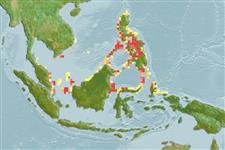Common names from other countries
>
Ophidiiformes (Cusk eels) >
Dinematichthyidae (Viviparous brotula)
Etymology: Ungusurculus: Name from Latin words 'ungulus' (= claw) and 'surculus' (= grapevine tendril), refers to the functional analogy with the pseudoclaspers and the specific shape of the inner pseudoclasper.; williamsi: Named in honour of Jeffrey T. Williams, USNM, Washington D.C..
More on authors: Schwarzhans & Møller.
Environment: milieu / climate zone / depth range / distribution range
البيئة
بحري القاع; نطاق العمق 0 - 4 m (Ref. 76869). Tropical
Western Pacific: Philippines.
الحجم / وزن / العمر
Maturity: Lm ? range ? - ? cm
Max length : 4.5 cm SL ذكر/ مختلط الجنس; (Ref. 76869)
وصف مختصر
مفاتيح التعريف | الوصف الخارجي | قياسات المظهر الخارجي
الأشعة الظهرية الناعمة (المجموع) : 79 - 85; أشعه شرجية لينه: 59 - 63; فقرات: 42 - 43. This species is distinguished by the following characters: D 79-85, A 59-63, D/A 24-26, V in D 2.2-2.4; vertebrae 12+30-31=42-43; anterior nostril located 1/4 the distance from upper lip to aggregate distance to anterior margin of eye; free pseudoclaspers 2 pairs, outer pseudoclasper wing-shaped with broad base and distally widened supporter without
anterior hook, while the inner pseudoclasper is short, half the length of outer one, with slightly broadened base, distally with two inwardly directed weak spines; cheeks with 4-6 scale rows on upper part and 3 rows on lower part; no upper preopercular pore; otolith compressed, its length to height is 1.9-2.1, pointed anterior and posterior tips, the latter expanded, projecting sharp postdorsal angle, short sulcus, wide with fused colliculi, its centre slightly anterior of centre of otolith, inclined about 10°, otolith length to sulcus length is 2.2-2.4 (Ref. 76869).
Based on collection site, this species is probably adapted to non-reef related rocky inshore environments (Ref. 76869). Cryptic and solitary, inhabitant of reef crevices and caves about 0-4 m (Ref 90102).
Life cycle and mating behavior
Maturities | التكاثر | Spawnings | Egg(s) | Fecundities | Larvae
Schwarzhans, W. and P.R. Møller, 2007. Review of the Dinematichthyini (Teleostei: Bythitidae) of the Indo-west Pacific. Part III. Beaglichthys, Brosmolus, Monothrix and eight new genera with description of 20 new species. The Beagle, Records of the Museums and Art Galleries of the Northern Territory 23:29-110. (Ref. 76869)
IUCN Red List Status (Ref. 130435)
CITES (Ref. 128078)
Not Evaluated
استخدامات بشرية
مصائد: غير ذات اهمية
أدوات
تقارير خاصة
Download XML
مصادر علي الأنترنت
Estimates based on models
Preferred temperature (Ref.
115969): 28.4 - 29.2, mean 28.8 (based on 199 cells).
Phylogenetic diversity index (Ref.
82804): PD
50 = 0.5156 [Uniqueness, from 0.5 = low to 2.0 = high].
Bayesian length-weight: a=0.00389 (0.00180 - 0.00842), b=3.12 (2.94 - 3.30), in cm Total Length, based on all LWR estimates for this body shape (Ref.
93245).
مستوى غذائي (Ref.
69278): 3.2 ±0.5 se; based on size and trophs of closest relatives
Fishing Vulnerability (Ref.
59153): Low vulnerability (10 of 100).
